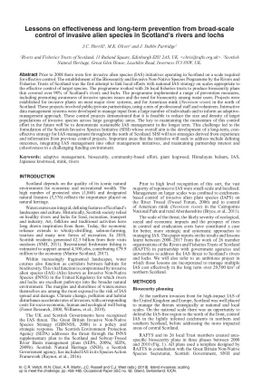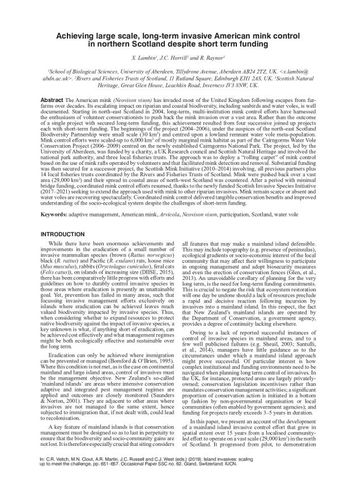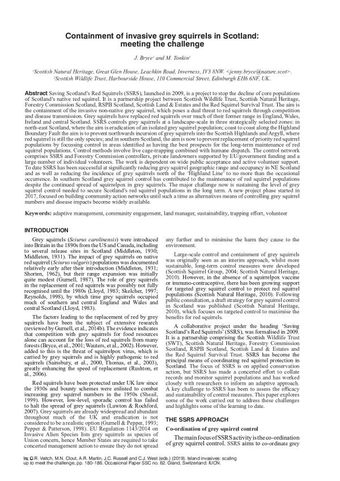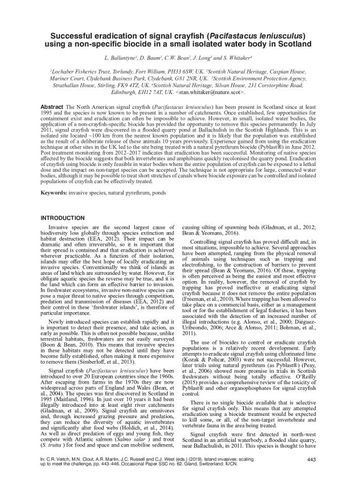Lessons on effectiveness and long-term prevention from broad-scale control of invasive alien species in Scotlands rivers and lochs
- Description:
- Prior to 2008 there were few invasive alien species (IAS) initiatives operating in Scotland on a scale required for e?ective control. The establishment of the Biosecurity and Invasive Non-Native Species Programme by the Rivers and Fisheries Trusts of Scotland was the ?rst attempt to link local e?orts with national IAS strategy on scales appropriate to the e?ective control of target species. The programme worked with 26 local ?sheries trusts to produce biosecurity plans that covered over 90% of Scotlands rivers and lochs. The programme implemented a range of prevention measures, including promoting awareness of invasive species issues and the need for biosecurity among water users. Projects were established for invasive plants on most major river systems, and for American mink (Neovison vison) in the north of Scotland. These projects involved public/private partnerships, using a mix of professional sta? and volunteers. Interactive data management systems were developed to manage input from a large number of individuals and to inform an adaptive management approach. These control projects demonstrated that it is feasible to reduce the size and density of target populations of invasive species across large geographic areas. The key to maintaining the momentum of this control e?ort in the future will be to demonstrate sustainable IAS management in the longer term. This challenge led to the formulation of the Scottish Invasive Species Initiative (SISI) whose overall aim is the development of a long-term, cost-e?ective strategy for IAS management throughout the north of Scotland. SISI will test strategies derived from experience and information from previous control projects. Important areas that the initiative will seek to address include de?ning outcomes, integrating IAS management into other management initiatives, and maintaining partnership interest and cohesiveness in a challenging funding environment.
- Display date:
- 2019
- Location:
- Pacific Region
- Collections:
- Secretariat of the Pacific Regional Environment Programme (SPREP)
- Publisher:
- International Union for Nature Conservation (IUCN)
- Content partner:
- Secretariat of the Pacific Regional Environment Programme (SPREP)
- Availability:
- Not specified
-
Copyright status: All rights reservedFind out more about what you are able to do with this itemThis item is all rights reserved, with means you'll have to get permission from Secretariat of the Pacific Regional Environment Programme (SPREP) before using it. For more information, please see our use and reuse page.What can I do with this item?Non-infringing useNZ copyright law does not prevent every use of a copyright work, and this item may be hosted by an international institute or organisation. You should consider what you can and cannot do with a copyright work.No sharingYou may not copy and/or share this item with others without further permission. This includes posting it on your blog, using it in a presentation, or any other public use.No modifyingYou are not allowed to adapt or remix this item into any other works.No commercial useYou may not use this item commercially.
Related items
Welcome and warm Pasifik greetings
The information on this site has been gathered from our content partners.
The names, terms, and labels that we present on the site may contain images or voices of deceased persons and may also reflect the bias, norms, and perspective of the period of time in which they were created. We accept that these may not be appropriate today.
If you have any concerns or questions about an item, please contact us.



